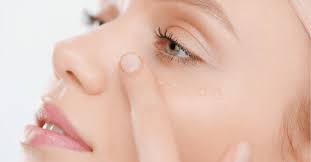
How To Apply Eye Creams and Serums
Applying eye cream consistently is a key part of a proper skin care regimen. As a dermatologist, I commonly advise patients to use an eye cream or serum twice a day – both morning and night – after cleansing. The delicate skin around our eyes is particularly prone to fine lines, wrinkles, dark circles, puffiness, and dryness. Using the correct technique to apply eye cream allows you to get the most out of your eye cream. Later in this post I will explain step-by-step how to properly apply eye cream or serum in both your morning and evening routines.
To find the best eye cream for you- visit this blog on how to choose an eye cream or take the skin type quiz and get a custom skin routine with many eye cream choices that are right for you.
How to Apply Eye Creams and SerumsHow much eye cream or serum to use
It important to use the correct amount of eye cream. We recommend 1/8th teaspoon of serum total for both eyes.
Correct Direction of Eye Cream Application
When applying eye products to the lower lid area, you want to rub towards the middle – towards the nose- so you are moving fluid towards the lymph nodes to speed lymph drainage.
When To Apply Eye Cream
When you apply your eye cream in your skincare routine is important because it will affect how well other products in your routine absorb into the skin around your eyes.
Apply Eye Cream Before or After Moisturizer?
Eye creams should be the second step in your daily skin care routine and applied before your moisturizer. Eye products, including serums, creams or gels, should be applied directly after cleansing.
3 reasons to apply your eye cream after cleansing:
The eye cream will be able to penetrate into the skin without having to pass through any other products
The eye cream will be able to fill in any creases in the skin to smooth away wrinkles.
Your eye cream will protect the delicate eye area from the third step in the skin care regimen.
Eye cream often have peptides, saccharides and other ingredients meant to fill in the spaces between skin cells and make the skin look smoother. They will not work as well if applied on top of other serums, gels and creams. The third step in a good skincare routine is often a treatment serum. These often contain ingredients that can irritate the delicate skin near your eyes. Applying your eye cream or serum before the treatment product can protect your eye from irritation from ingredients like retinoids, benzoyl peroxide, and hydroxyacids.
Apply Eye Cream in the Morning or Night?
Eye creams should be applied both in the daytime skin routine and at night before bed. It is most important to use an eye cream at night.
At night, your other skin care products often rub off onto your pillowcase and transfer to the eye area. These products can irritate delicate eye skin- especially retinoids and hydroxyacids. So -it is a good idea to use a protective eye cream under your eyes at night – especially if you are using retinoids like retinol. The eye cream – especially a barrier repair eye cream- will protect the eye area from any irritating skin care products or detergents on your sheets and pillowcases. This is very important for sensitive skin types.
Apply Eye Cream before or after Sunscreen?
Sunscreen is applied after eye cream, serums, and moisturizers. Sunscreen is the last skin product to apply to the skin before using makeup.
You can also choose an eye cream that has sunscreen i it such as one of these below.
[[S19,S19T]]
Eye Cream or Eye Serum First?
Never use an eye cream or an eye serum at the same time because you are wasting money and reducing the effectiveness of both products. However, you may choose to use 2 different eye creams or serums: one in the am and one in the pm.
When to Start Using Eye Cream?
My patients often ask me what age to start using eye cream- but when to start does not depend on your age- it depends on which Baumann Skin Type you are and what eye area concerns you have.
It is never too early to begin using an eye cream or eye serum- however they are not necessary unless you are having one of these issues:
Dry skin on the eye lids
Fine lines under the eyes
Crow’s feet wrinkles
Eye puffiness
Red or stinging eyes
Discoloration, dark circles or darkness under the eyes
There is one exception to this rule. If you are a W Baumann Skin Type – this means you are wrinkle-prone and need to use an eye cream or serum to prevent wrinkles.
If you a e not a W Baumann Skin type, you can start using eye products to prevent these issues, or you can use your facial moisturizer around your eyes until you develop one of these issues. In some cases, it is important to use an eye cream to prevent eye irritation from other products such as anti-aging or acne products.
Different Eye Products for Morning and Night?
These are the factors to consider when deciding which eye product to use in the am and which to use in the pm:
Do you wear makeup? If so, apply an eye cream before your concealer. You can also mix it with your concealer before you apply it. Think of your eye cream or eye serum as a primer for concealer. This is very helpful if you have flaking of the eye area from retinoids or dark circles under the eyes.
Are you using a retinoid at night? If yes- use an eye cream for night to protect the delicate eye area from retinoid side effects.
Are you having redness or irritation of your eye area? Apply a soothing eye cream in the am or pm that has anti-inflammatory ingredients.
Do you have eczema around the eyes or eyelid dermatitis? Use eye cream am and pm.
Do you have puffy eyes? Use the anti-puffiness eye product at night because puffiness is usually worse when you wake up in the am. This will help prevent fluid accumulation under the eyes at night.
Here are some of the best hydrating eye creams:
[[E04]]
Eye Cream on Upper Eyelids
If you want to put an eye product on your upper eyelids, an eye serum is usually better than an eye cream because it is less heavy and less likely to run into your eyes. Avoid eye serums with a lot of alcohol because this can burn your eyes.
Here is a list of short chain fatty alcohols that are eye irritants and should not be used on the upper eyelids:
Ethanol / Ethyl alcohol
Isopropyl alcohol
Sodium lauryl sulfate
Ammonium lauryl sulfate
Laureth-4
Ceteareth-20
Steareth-2
Cetyl alcohol
Stearyl alcohol
The skin around the eyes is extremely delicate and thin. Using products containing these short chain alcohols can lead to stinging, burning, itching or dryness when applied to the eye area.
Do not use eye creams with hydroxyacids on your upper eyelids.
Using Eye Cream on Your Face
Never use an eye cream on your entire face! Eye creams are designed specifically for the eye area. Using eye creams on the face can lead to clogged pores and black heads. The difference between eye cream and face cream is the underlying formulation- not the active ingredients. The eye cream is meant to make a thin primer layer on the skin that masks dark circles, reflects light, fills in creases under the eyes and allows makeup up to go on smoothly.
Eye creams sometimes contain comedogenic ingredients. Using eye creams all over the face can cause milia.
Using Face Moisturizer as an Eye Cream
Eye creams are often expensive- but are they worth the price? Could you use a face cream under the eyes instead? In some cases, you may want to lower your skin care costs by eliminating a product. In our opinion, the eye cream/ serum is the first skin care product to eliminate when you are on a budget. Or- maybe you are going on a trip and you need to free up space in your luggage- you can leave your eye cream at home. But- what to use instead of eye cream? Your facial moisturizer! As long as it does not have retinol, hydroxyacids or benzoyl peroxide or strong fragrances- you should be able to use a facial moisturizer as an eye cream.
I personally use Zerafite Wrinkle Defense Barrier Cream as an eye cream over Plated Serum. I mix it with my concealer and apply it over Plated serum under my eyes. I do not use the Zerafite only upper lids.
I apply Plated Intense Serum to my upper and lower eyelids. This serum has antiaging exosomes and layers well under a facial moisturizer.
(The Plated packaging says not to use in the eye area but I confirmed with the cosmetic chemist that there is no reason to not use it in the eye area.)
There is a lot to know about correctly using eye creams and serums. It is worth learning about because eye products are expensive. We would hate to see you wasting time and money on the wrong eye products, or by using them incorrectly.
Make sure you take the quiz to find out the best eye products for you and get a customized skin care routine. Then you can browse and see what eye products from many different brands and price points are right for you.


